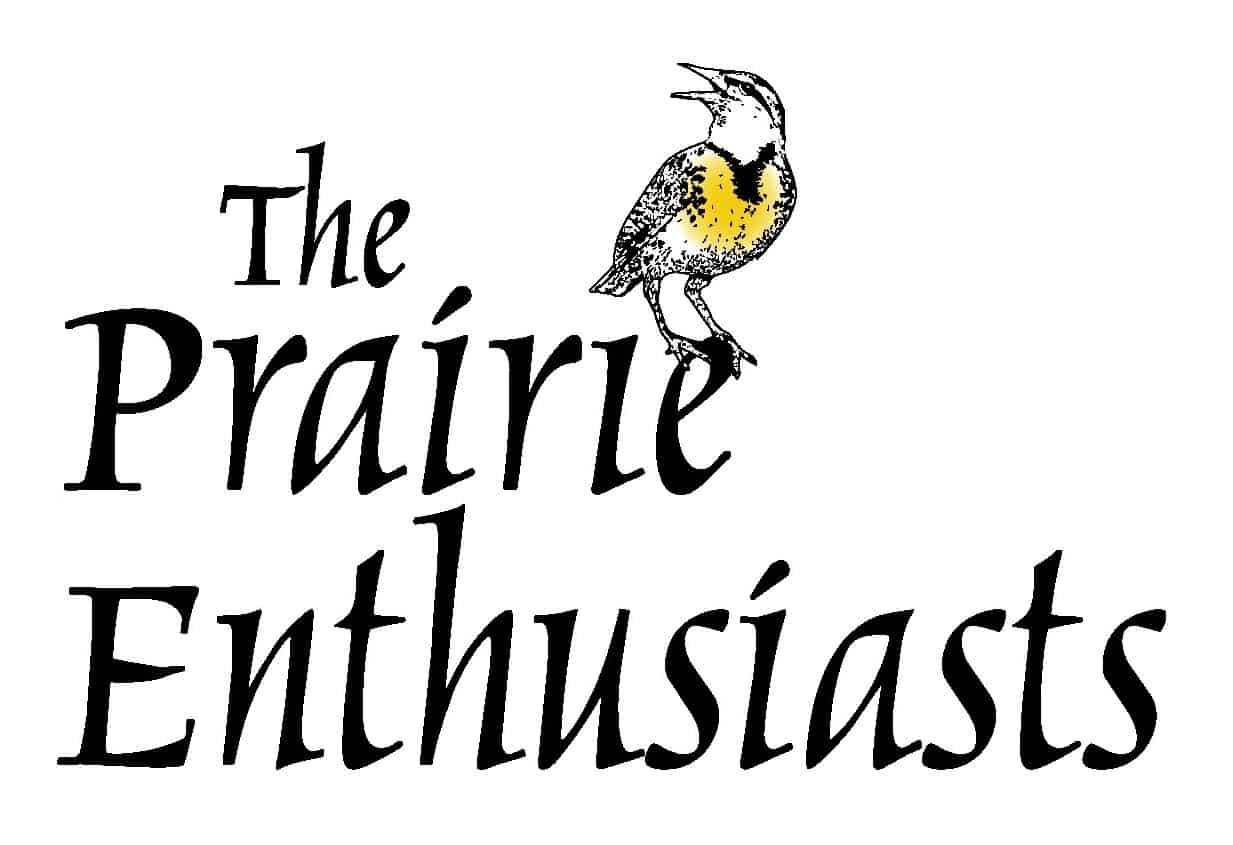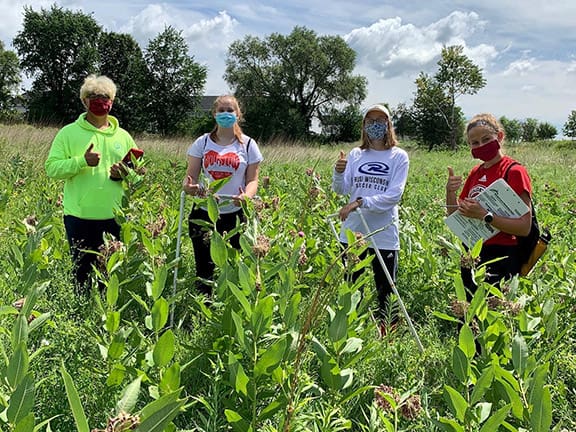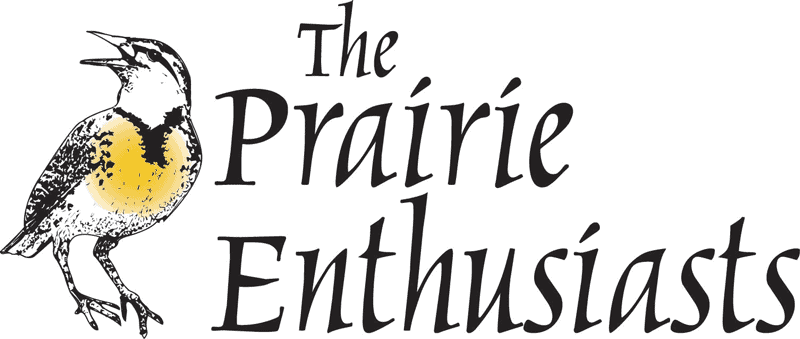
by The Prairie Enthusiasts | Sep 2, 2020 | News
This article was a collaboration with Grace Vosen and is an update to an article in our August 2019 newsletter. Read the original piece here (navigate to page 5).
The New Ulm (Minnesota) area is seeing a renewed interest in prairie. Residents, and especially educators, are working to understand the history of prairies and to restore them on the landscape. Since 2017, TPE’s Many Rivers Chapter has been partnering with two local schools to create outdoor classrooms.
Our chapter has been tending to a 3/4-acre prairie planting at New Ulm’s middle school. After three growing seasons, we seem to have gained the upper hand on undesirable species left in the seed bank. This spring, Steven Gahm and I grew some seedlings and planted them in a corner of the plot that is easy to weed. We hope that these prairie plants will show passersby that the site is being tended. We also plan to re-seed the entire lot this fall.

Plant identification plot at New Ulm High School. Photo by Jim Vonderharr
Amber Gremmels, the middle school science teacher who initiated the project, has since become a member of TPE. She says that while it took hard work, the planting has played an important role in familiarizing her students with nature. “Many middle school students have the misconception that anything other than a lawn, purposefully planted garden, or landscape space is weeds,” says Amber. “My hope is that I scratch the surface as far as helping our youth understand ecosystem dynamics, and how decisions within a community impact those dynamics.” To date, Amber has used the planting for lessons in phenology, qualitative and quantitative nature observation, and edible plants.
Meanwhile, the high school prairie project looks very promising. In 2019, we worked with science teacher Matt Nelson to create plant identification plots in the learning space outside of his classroom. We planted 48 single-species plots of two feet by four feet. Because we used seedlings, this site is a ready-made display of prairie diversity. We also planted a variety of native shrubs and trees. A few were lost over the winter, but most still stand.
Both projects are off to a great start but have been slowed by CoViD-19. Students haven’t been at the schools since March, and student “sweat equity” was a big part of our plan to keep the plantings in working order. We will need to come up with a creative solution that considers the health of the students as well as the prairie.
We want to thank the New Ulm Chapter of the Izaak Walton League for helping us solve the problem of cost. Brad Gaard (also a TPE member) is our contact there who provided the funding. It should be noted that this group is in the process of developing a piece of prairie on their own property just outside of New Ulm. Thanks also to the TPE team working on these projects: Henry Panowitsch, Gary Rathman, Jim Lynch, and Jim Vonderharr. We hope to continue partnering with local institutions to make education a major goal of our operations.
 New Ulm High School’s outdoor classroom. Photo by Jim Vonderharr
New Ulm High School’s outdoor classroom. Photo by Jim Vonderharr

by The Prairie Enthusiasts | Sep 2, 2020 | News
In 2019, the site stewards of Moely Prairie joined forces with Sauk Prairie High School to implement a summer internship program. Participants report to the prairie once a week and conduct monarch monitoring research. Not only are these exceptional students documenting meaningful data for scientists, but they are also learning about the need to preserve vanishing pollinator habitats.
 The interns head into Moely Prairie. Photo by Amy Chamberlin
The interns head into Moely Prairie. Photo by Amy Chamberlin
The program had its start just two years ago. We at Moely were aware that monarch populations were dwindling, but I honestly didn’t know much about the specifics of their plight. In early 2018, I attended a presentation by Karen Oberhauser, monarch researcher and director of the University of Wisconsin Arboretum. She explained the myriad of reasons for the sharp decline of monarchs and spoke highly of a monitoring program that was collecting data on the species. This citizen science project was the Integrated Monarch Monitoring Program (IMMP).
Monarch monitoring and our work at Moely Prairie seemed perfectly aligned. Our restoration efforts at this remnant sand prairie in south-central Wisconsin was creating habitat for monarchs and other declining pollinators. Inspired by Dr. Oberhauser, my husband Rick and I began collecting data for IMMP that summer. We attended a local training session led by Jennifer Thieme of the Monarch Joint Venture. Soon after, we established our first monarch monitoring plot at Moely. That first year, we eased our way into the program by monitoring blooming plants and milkweed populations, both crucial for monarchs.
A generous grant from the Wisconsin Natural Resources Foundation allowed us to take on four interns in 2019. They were all students of Patrick Leigh, science teacher at Sauk Prairie High School. They conducted all levels of IMMP research. This included assessing nectar habitat, counting milkweed plants to inspect them for eggs or larvae, observing adult monarchs, and tracking parasitism.
 Monitoring monarchs at Moely. Photo by Amy Chamberlin
Monitoring monarchs at Moely. Photo by Amy Chamberlin
When our first “class” presented about their experience to the school district board in 2019, no one was prouder of them than me. As I listened to these young women talk about what they’d learned, I heard some of them say they were considering careers in science and research. Others were applying their experience to other conservation efforts, even growing native pollinator plants in their backyards.
The internship is now in its second year, largely supported by monetary donations from the local community. We’ve been fortunate to have a total of 8 students in the program since its inception. Some choose to bank volunteer hours, while others are earning science credit toward graduation. When their research ends in the fall, the students also complete presentations to various community groups, sharing the experience and knowledge gained from participating in the program.
Hands down, mentoring these students is my biggest motivation to stay involved with IMMP research. And even when the interns are done collecting data for the summer, we continue to collaborate with Sauk Prairie High School staff and administration. We, as land managers, are invited into science classrooms to give presentations about the biodiversity found in prairie ecosystems and the importance of preserving and restoring them. We also lead field trips and provide opportunities throughout the year for students to take part in hands-on restoration. These include their annual Day of Service, classroom initiatives, and our monthly work parties (where students often enlist the help of their families).
This theme of “planting seeds” of inspiration with kids and families has been a common thread woven into my career and persists even now in my retirement. Standing in the middle of a milkweed patch on a small remnant prairie in Prairie du Sac, I’m so grateful that I can continue to sow seeds with these future conservationists. For it is our young people that will carry our conservation torches forward — and to me, it’s the best investment any of us can make.

Monarch monitoring intern class of 2019 (above) and 2020 (below).
Photos by Amy Chamberlin


by The Prairie Enthusiasts | Aug 5, 2020 | News
This article was a collaboration with Pamela Eyden.
Motivated to reverse habitat loss and fragmentation, a team of private landowners (the Pleasant Valley Pollinator Corridor or PVPC Team) began this spring to work toward creating a pollinator corridor in Pleasant Valley outside Winona, Minn. These landowners have worked for many years to manage natural areas and establish native plantings on their own private properties. Creating a corridor of native habitats in the 10-mile long valley was a new step.
Restoring high-quality remnant bluff prairies and oak savannas has been an important focus. Gabe Ericksen, a longtime TPE member and owner of LandSpirit Design Landscaping, worked with the private landowners and the local Minnesota Driftless chapter of TPE to coordinate the restoration of 30 acres on Bluff Prairie. As the name suggests, this prairie is on a steep bluff that rises out of the hillside near the entrance to Pleasant Valley (see photo).
Trees and woody vegetation had encroached on the bluff; these were the first to go. The group is now re-vegetating the site with seed collected there, doing prescribed burns to manage the brush, and continuing work on the savanna below the prairie. They are also monitoring and documenting endangered species such as the rusty-patched bumblebee, endangered skipper butterflies, and race runner lizards.

Bluff Prairie at the entrance to Pleasant Valley. Photo by Gabe Ericksen
Here is a drone video of Bluff Prairie by Gabe Ericksen, taken during a spring burn in March 2020:
https://www.facebook.com/772973708/videos/pcb.10159401137478709/10159401134023709
Another view, from a workday in December 2019:
https://www.facebook.com/stephen.winter.395/videos/10159024455503709
The second focus is to add pollinator habitat on private homeowner properties throughout the valley. Led by Roberta Bumann, another TPE member and a Minnesota Master Naturalist, the team partnered with Healthy Lake Winona, a Winona-based nonprofit, to apply for a Lawns to Legumes Demonstration Neighborhood grant from the Minnesota Board of Water and Soil Resources in the spring of 2020. This Minnesota state-funded grant is available to nonprofit organizations to assist residential homeowners in creating native plantings. It aims to provide habitat for the endangered rusty-patched bumblebee (last sighted in 2018 in Pleasant Valley) and other at-risk pollinators. The PVPC Team is working with homeowners to install four types of plantings: pocket gardens, rain gardens, pollinator meadows in yards or along roadsides, and pollinator-friendly shrubs and trees. Round 1 began in the spring of 2020 and is reflected in the Project Map below. Round 2 will begin this fall with an end goal of forty residential homeowners receiving grant funds.
Besides financial assistance, the PVPC Team created resources to support the project. These include a high-diversity seed mix for meadow and roadside plantings and a native plant plan for pocket gardens that uses seeds and plants appropriate for the ecoregion. The Team recognized that education and community support are critical for homeowner success in establishing and maintaining native plant habitats. They set up a coach-led structure that uses PVPC Team members as coaches who meet with each homeowner to guide their project. They also created a website for the project at www.pvpollinators.com.
As of last month, four individual pocket gardens have been installed. More landowners are working on site preparation in advance of planting pollinator meadows this fall. The grant project will continue and be evaluated for five years.
In addition to Ericksen and Bumann, the PVPC Team is comprised of John Carrier (Wildlife Biologist), Kim Ericksen (Database Specialist), Pamela Eyden (Healthy Lake Winona), Amanda Gentry (Winona County Soil & Water Conservation District), John Howard (City of Winona Sustainability Coordinator), Joshua Lallaman (Biologist), and Kaitlyn O’Conner (Prairie Moon Nursery).
Corridors connect habitats, allowing for wildlife and plant movement. They can help reestablish populations in core habitats and after prescribed burns, help increase genetic diversity, and help create habitat large enough to sustain populations. Connecting the core habitats of the stream buffers, valleys, wooded hillsides, oak savannas, and bluff prairies in the Pleasant Valley watershed promotes the health and proper functioning of this Driftless Area ecological system. By restoring bluff prairie and oak savanna and adding pollinator-friendly habitat, the Pleasant Valley Pollinator Corridor project aims to restore and enhance the fire-dependent ecosystems in Pleasant Valley for the benefit of all living therein – pollinators, plants, wildlife, and people.
Check out more photos of the project below!

Pleasant Valley Pollinator Corridor project map. Map by Amanda Gentry
 Pollinator meadow in a valley bottom. Photo by Roberta Bumann
Pollinator meadow in a valley bottom. Photo by Roberta Bumann
 Roadside pollinator meadow. Photo by Roberta Bumann
Roadside pollinator meadow. Photo by Roberta Bumann

Planting a pollinator pocket garden. Photo by Gabe Ericksen

Monarch caterpillar on butterflyweed (Asclepias tuberosa). Photo by Roberta Bumann

Rusty-patched bumblebee on Culver’s-root. Photo by Gabe Ericksen

by The Prairie Enthusiasts | Aug 5, 2020 | Inspiration
Updated 12/5/2024
In the heart of Driftless Wisconsin lies Viroqua, home to the Prairie Enthusiasts Chapter Support office. We are lucky to be surrounded by many prairie remnants, State Natural Areas (like Romance Prairie), and several public native gardens within walking distance of the office. One consists of a planted prairie and small oak savanna between two schools.
This outdoor classroom is an urban oasis for bees, butterflies, and birds. What was once an asphalt playground has been transformed into a native plant “Greenspace.” The Prairie Enthusiasts staff have led field trips for students there and assisted with the management plan. As you will see, the native plants are a wonder to behold.

Sign greeting visitors to the PRWS Greenspace. Photo by Joe Rising
From the Pleasant Ridge Waldorf School website:
“In 2012, Pleasant Ridge Waldorf School (PRWS) was able to begin the Greenspace Permaculture Garden in the area between PRWS and the Landmark Center. This had been the former roadway (East Ave) and was an asphalt playground area between the two schools. It was prone to flooding during the spring thaw and generally had limited aesthetics for our school grounds. The focus of this project was twofold: 1) to provide another outdoor classroom area for the children that would incorporate our native habitats of the Driftless Area as well as edible landscaping using Permaculture design, and 2) to enhance the aesthetic of this school and public area between the neighborhoods surrounding our school while improving the infiltration and drainage of water on the site.”
Mark Shepard, a permaculture expert and designer of the PRWS garden, said he “used two different seed mixes both sold as blends by Prairie Moon Nursery [in Minnesota]. The majority was the PDQ mix and in the ‘rain garden’ corner it was their wet prairie blend. I haven’t seen a whole lot of wetland associated species… I especially wanted the Joe-Pye weed to flourish because I have fond memories of it as a lil’ tyke.”
Learn more about the School’s nature programs and outdoor classrooms here.
Thanks to Chris Larson for helping assemble this photo gallery. She has a great eye for natural beauty.

Construction begins. Photo by Cynthia Olmstead

The completed Greenspace. Photo by Joe Rising

Joe Rising and his daughter help plant the prairie. Photo by Cynthia Olmstead

The Prairie Enthusiasts staff lead a prairie plant tour. Photo by Kay Fandel

Chris Kirkpatrick, former Executive Director for The Prairie Enthusiasts, identifies native plants. Photo by Kay Fandel

Black-eyed Susan (Rudbeckia hirta). Photo by Joe Rising

Many compass plants (Silphium laciniatum) have sprung up. Photo by Chris Larson

A summer bouquet: rough blazing-star (Liatris aspera) and purple coneflower (Echinacea purpurea).
Photo by Joe Rising

Partridge pea (Chamaecrista fasciculata). Photo by Joe Rising

White wild indigo (Baptisia alba). Photo by Chris Larson

The beauty of native habitat. Photo by Cynthia Olmstead

by The Prairie Enthusiasts | Aug 5, 2020 | News
The Many Rivers Chapter was recently featured on the Minnesota DNR’s Prairie Pod podcast. Chapter chair Henry Panowitsch represented TPE on the episode titled “A Legacy of Love for the Prairie Landscape: A Landowner’s Perspective.”
Henry kicks off the discussion by pointing out that “it’s never too late to do the right thing.” He shares some lessons learned from decades of volunteering and strategies to involve all generations in restoring the landscape. You will also hear what motivates Henry and his fellow Prairie Enthusiasts, and why he feels that “the ‘P’ in ‘prairie’ stands for ‘patience’.” Don’t miss it!

Henry Panowitsch at the Many Rivers Chapter’s solstice bonfire.
Photo by Steven Gahm


 New Ulm High School’s outdoor classroom. Photo by Jim Vonderharr
New Ulm High School’s outdoor classroom. Photo by Jim Vonderharr






 Pollinator meadow in a valley bottom. Photo by Roberta Bumann
Pollinator meadow in a valley bottom. Photo by Roberta Bumann Roadside pollinator meadow. Photo by Roberta Bumann
Roadside pollinator meadow. Photo by Roberta Bumann















